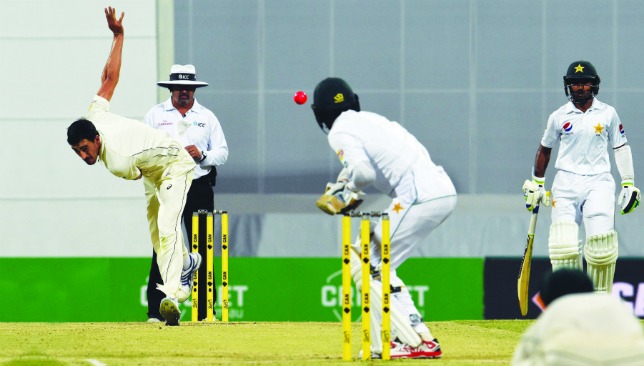
For Cricket Australia, this is the way forward. In fact, there is a possibility of two pink-ball Tests becoming the part of their annual calendar. People love it, the crowds flock in and it is TV gold. No board is going to say no to that.
Most of the dialogue until now has been about how pink ball cricket can inject life into Tests and make it more attractive to a new group of fans.
Johnson, however, sees it in a totally different light.
Current players are trying their best to get accustomed to the playing conditions as quickly as they can.
Because, let’s face it, most teams will begin to play them regularly soon.
Certain players are overcoming serious hurdles to participate in the endeavour, with colour-blind wicketkeeper Matthew Wade featuring in the first Test against Pakistan.
According to Wade, “you’ve just got to get used to it”. Which is what most players are doing at the moment.
But Johnson has the luxury of passing his judgment as he doesn’t play Tests anymore. And there is every chance of his sentiment being shared by many current players, even if in private.
The former left-arm pacer believes day-night Tests alter the playing conditions too much to be considered on par with red ball Tests. Since the pitch has to be of a certain kind, with more than enough grass covering to stop the pink ball from losing its shine quickly, bowlers are always in with a chance and under lights, the ball definitely swings a great deal.
According to Johnson, that results in a scoreboard that doesn’t truly reflect the strengths and weaknesses of players. Seam bowlers who would otherwise have been whacked around suddenly become menacing and good batsmen end up looking a bit foolish. It might not happen all the time but has occurred in the handful of daynight Tests we have had so far.
Also, skippers Steven Smith and Alastair Cook have stated that Ashes cricket is already well attended and doesn’t need a pink ball Test to raise interest.
However, if we go by that logic, then it means we should have day-night Tests only in series that aren’t ‘major’. That would be a clear a demarcation in Test cricket and in my book, not necessary. If pink ball cricket has to be tried out, everyone must do it regularly and across different venues.
But even so, the questions raised by Johnson and others are pertinent and since these are players synonymous with Test cricket, their displeasure has to be noted.
We haven’t seen yet what the pink ball does under lights in the subcontinent. We might encounter new problems then and a few more murmurs would start.
So on the one hand, we have a daring experiment in the longest format of the game and on the other players who believe that’s pushing it too far. What to do then?
I believe players must get on with it and look to put the crowd and fans before everything else, when it comes to pink ball cricket.
Yes, it may not be ‘normal’ and the results may not reflect an accurate picture. But that should, at least during the initial ‘testing phase’, be seen as a necessary inconvenience.
Once players accept day-night Tests as a unique but important part of the process, it should be easier to overlook some of the drawbacks. Then, it won’t matter whether it’s an Ashes series or not.
Since an attempt is being made to find new pastures for Test cricket, a few bumps along the way should not be seen as end of the road.
Test cricket is the collective responsibility of boards and players because a format like T20 finds takers even at domestic level. Not every Test nation plays its home games in front of sell-out crowds, unlike Australia and England. Pink ball cricket, therefore, might be the only way forward collectively.
How late is too late? Staying with pink ball cricket, the first Test at the Gabba saw an incredible finish to the fourth day’s play. Australia captain Steven Smith asked for an extra half hour at the end of an already extended final session, hoping to snare the final three Pakistan wickets and win the match on the fourth day.
However, Pakistan lost just one wicket in that period, scored 51 runs and reached within 108 runs of their mammoth target of 490 with two wickets still in hand.
The match which was supposed to finish at 8pm local time got over after 10pm on Sunday. While night finishes aren’t anything new to cricketers, successive late nighters are a new phenomenon thanks to day-night Tests.
Until now, players experienced late games only during limited overs matches or during T20 tournaments.
But five successive days of play under lights is an area that has not been explored. And when even that deadline is pushed past 10pm, you can expect some harried players.
When Australia played Pakistan in an ODI series in the UAE in August 2012, the matches finished after midnight and the pressers had a lot of sleepy heads. Guess it will become the norm now.